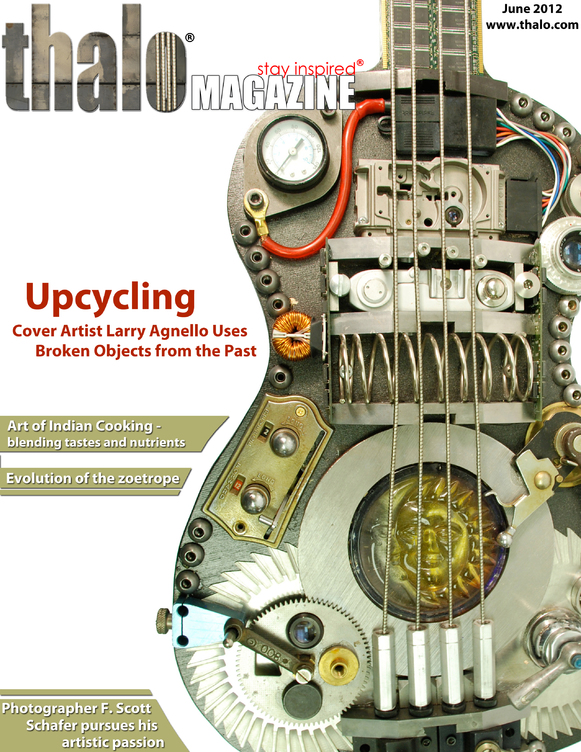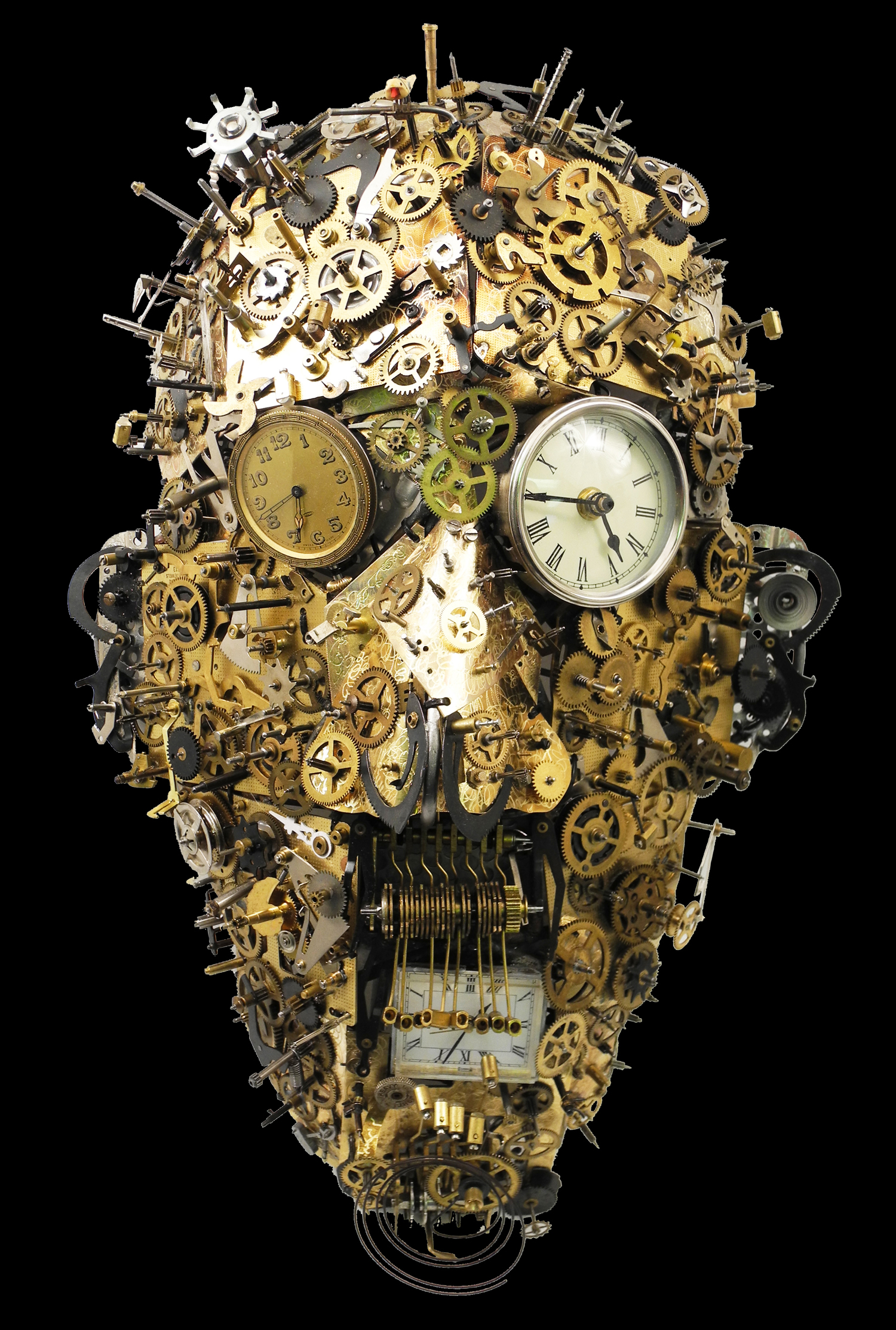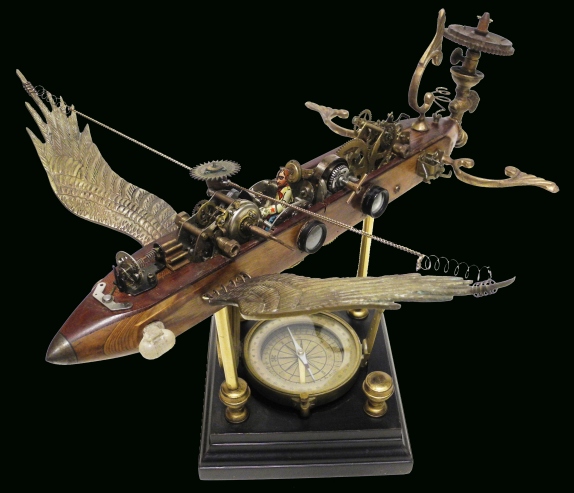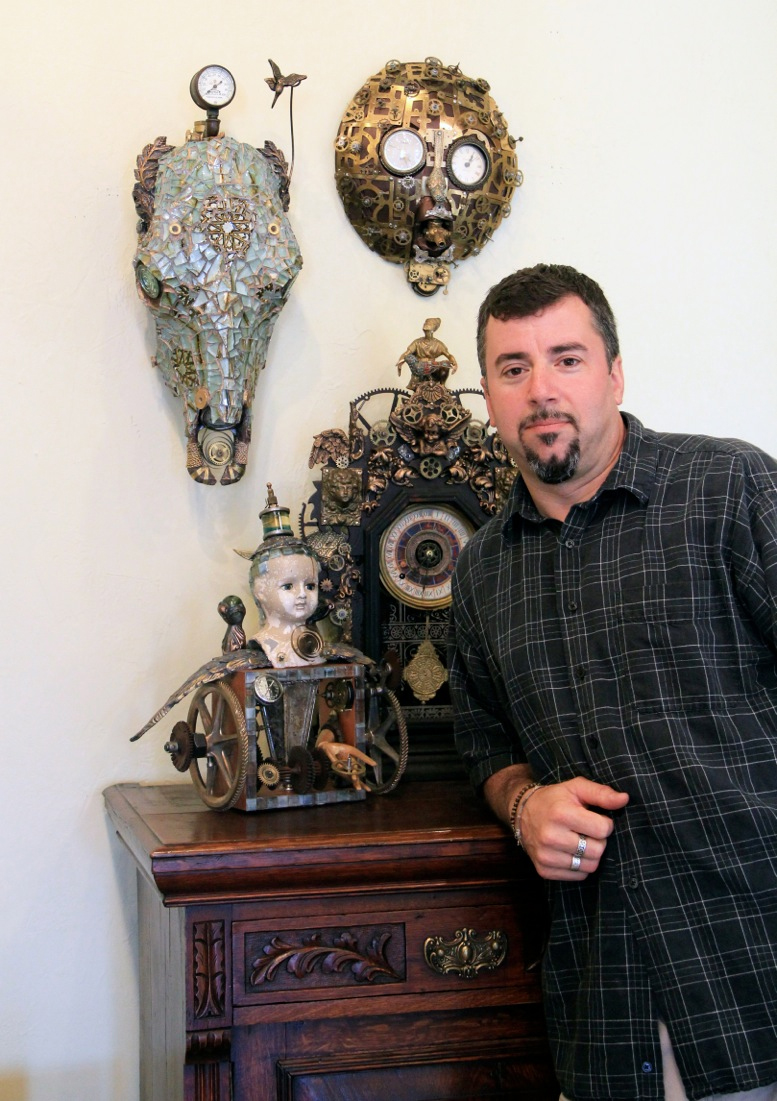
June Cover ArtistCover Artist: Larry Agnello 


Larry Agnello grew up on the north shore of Long Island in New York. Larry has worked as a Graphic Designer for over twenty years, designing book covers for a New York publisher for 15 years. During a trip to Africa in 1989, Larry spent eight months backpacking through several East African countries and doing volunteer work in different villages. The trip also produced thousands of photographs which are, to this day, the source for much of his artistic inspiration.
In 2008 he relocated to Indianapolis, and since then has re-dedicated himself to his sculpture, painting, and wood carving. His art is featured at the Renaissance Fine Art Gallery in Carmel, IN, and his sculpture recently won “Best in Show” and “People’s Choice” Awards at a juried exhibition at the Art Sanctuary in Martinsville, IN.
Larry recently began creating sculptures from clock parts and scrap metal, and also started work on some unique mosaics with glass, stone, and marble. His love for African art and masks found it's way into his own art and lead to sculptures and mosaics using scrap metal, broken glass and stone, old wood, and found objects. Even these discarded pieces can still make beautiful objects. Lasting objects that could be from the past or future, old or new.
thalo: Tell us a little about the guitar featured on the thalo cover. How do you approach creating a piece like this?
Larry Agnello: : I happen to love music, especially guitar music, but I have absolutely NO musical ability at all. So I tried to use my artistic talent to express how I feel about guitars, the amazing range of sounds, the beauty of the shapes, the technical aspects of the instrument. I usually start out with two or three found objects besides the base object, in this case the wood guitar shape. Once those two or three pieces are installed in key places, the rest just seems to build on that, and it's amazing when pieces just start fitting together, like they were always meant to be there.
th: : You talk about the concept of “upcycling.” What does this mean to you?
LA: Walk into any Goodwill or Salvation Army store and you'll see that the country is becoming buried in used, discarded junk. Everything has become disposable. Years ago, things were made to last and people valued them, took care of them. Now everything is made cheaply, and quickly discarded. Upcycling is a way of taking discarded or broken objects, worth almost nothing, and reusing them to create something new, something with a higher purpose. If you can create a sculpture or a piece of art from old discarded junk, that is truly Upcycling.
.
th: You also work with traditional media such as paint and film. Do you find it challenging to move from one medium to another?
LA: I think all forms of art are very connected, regardless of medium. Art is a way of looking at things, the way you see your surroundings, and then expressing it in one medium or another. Sometimes ideas are more easily expressed in a painting, or a photograph. Lately, for me, I'm finding it easier to express myself through my assemblages. I've always collected things, since I was a kid. I could never throw anything away, and I always picked up little things, anything that had an interesting shape, or texture, or color. And now suddenly I have a use for all these things. When I run out, maybe I'll find some other medium that allows me to be creative.
th: What do you like about sculpture and mixed media that you can’t achieve in other forms?
LA: I feel like with mixed media I can experiment much more and produce more original artwork than I could with painting or photography. Not that there aren't artists out there that doing original things with paint or photography, but I had a hard time developing an original style that satisfied me. Nothing that seemed original enough. I also never felt completely satisfied with my paintings once they were finished, I wanted every painting to be a masterpiece and they never were. I wasn't able to see a painting as an experiment, so I was never able to relax enough to feel comfortable in my style. For some reason I'm able to do that with my assemblage. I've always had an appreciation of mechanical things, like clocks and machines with gears and moving parts. There are less and less these days, so when I find an antique clock, or an old typewriter or sewing machine, I really enjoy opening it up and taking it apart, finding all the great pieces inside. And that of course leads my imagination to begin thinking about all the things that these parts could be. They could be rebuilt, rearranged in a million different ways, to create something new and beautiful from something old and broken.
th: Where do you find inspiration for you work?
LA: A lot of my inspiration comes from primitive art. I've always been fascinated by Mayan and Aztec carvings and symbols, and I love primitive African Wood Masks. I love how they used bits of stone, glass, bone, or metal to decorate them. In 1990 I spent some time in Africa, and I realized that people still create art from whatever materials are readily available to them, whether it's plastic, old wood, wire, or rusty old nails. And not just art. Household items, toys, anything, made from things that surround them. So when I go into a thrift store and see all these old discarded objects, whether they are wood, glass, or china, they look to me like "art supplies."
To see more of Larry Agnello's work visit www.assemblique.com.
permalink | past covers

